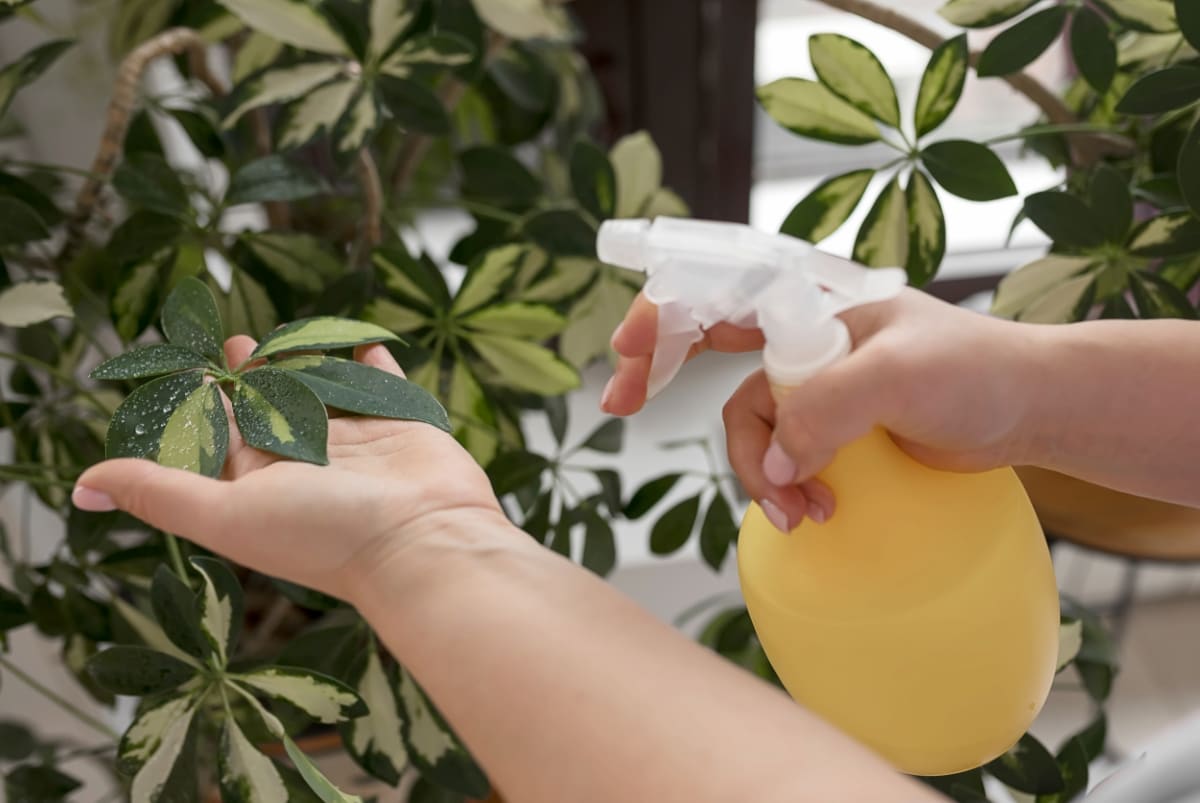Brown spots can significantly impact the health and appearance of flower plants. Brown spots can weaken the plant’s overall health, affecting its ability to grow and thrive. It may lead to stunted growth, wilting leaves, and reduced flowering. If left untreated, these spots can spread throughout the plant and infect neighboring plants.

How to Treat Brown Spots on Flower Plants
Common Causes of Brown Spots on Flower Plants
Brown spots on flower plants can be frustrating for any gardener. These unsightly markings not only detract from the beauty of the plants but also indicate underlying issues that need to be addressed. Understanding what causes these tiny brown spots on plant leaves is crucial in finding effective solutions.
Nutrient deficiencies can manifest as brown spots on flower plants. Lack of essential nutrients like iron, magnesium, or nitrogen can affect plant health and lead to browning of foliage. Environmental factors like excessive sun exposure or waterlogged soil can cause stress and brown spots. Insect infestations are another potential cause of brown spots on flowers. Pests like aphids or spider mites feed on plant tissues, leaving damaged areas with characteristic discoloration.
Addressing these issues naturally requires a multi-pronged approach. Organic methods such as proper watering techniques, promoting good air circulation around plants, promptly removing infected leaves, and applying natural pest control measures can help prevent and know how to treat leaf spot disease effectively.
Natural Remedies for Brown Spots on Flower Plants
- One effective method is organic neem oil, a potent fungicide that helps combat fungal infections causing brown spots. Mix a few drops with water and spray it onto the affected areas regularly.
- Another natural remedy is a mixture of baking soda and water, which acts as an anti-fungal agent. Apply this solution to the leaves and stems of your plants every few days until the brown spots disappear.
- Pests like aphids or mites contribute to brown spot development; try introducing beneficial insects such as ladybugs or lacewings into your garden. These predators will happily feast on these pests without harming your flowers.
Organic Methods to Prevent Brown Spots on Flower Plants
Proper Plant Care: One of the best ways to prevent brown spots on flower plants is by providing them with proper care. This includes watering your plants regularly but not overwatering them, which can lead to fungal infections. Additionally, ensure your plants get enough sunlight and have good air circulation.
Crop Rotation: Practicing crop rotation in your garden can help prevent the buildup of pathogens in the soil that could contribute to brown spots on flower plants. Rotate different flowers or vegetables each season to disrupt pest and disease cycles.
Good Hygiene Practices: Maintaining good hygiene practices in your garden is crucial for preventing brown spots on flower plants. Remove any infected plant debris promptly and dispose of it properly to avoid spreading diseases.
Natural Pest Control: Implementing natural pest control methods such as introducing beneficial insects or using organic insecticides can help minimize insect infestations that may contribute to treat brown spots on plants naturally.
In case you missed it: How to Treat Brown Spots on Vegetable Plants Naturally: Causes, Fix with Organic Home Remedies

Home Remedies for Fungal Infections Causing Brown Spots
Baking Soda – Create a solution by mixing baking soda with water, then apply it to your plants using a spray bottle. This alkaline mixture helps create an inhospitable environment for fungi to thrive.
Garlic Mixture – Garlic also possesses natural anti-fungal properties. Crush a few cloves and steep them in water overnight. Strain the mixture and regularly use it as a foliar spray on your plants to keep fungal infections at bay.
Vinegar – Additionally, vinegar is known for effectively killing fungi. Mix vinegar and water equally in a spray bottle and spritz it onto the infected areas or even underneath leaves where fungus often hides.
Organic Methods to Address Nutrient Deficiencies Causing Brown Spots
One effective way is using compost or organic fertilizers rich in nutrients like nitrogen, phosphorus, and potassium. These natural amendments provide a slow release of nutrients over time, promoting healthy leaf development and reducing the occurrence of brown spots. Mulching around your plants with organic materials such as straw or wood chips helps conserve moisture and regulate soil temperature.
This encourages beneficial microbial activity in the root zone that aids in nutrient absorption. Addressing brown spots requires identifying their root cause. This could involve implementing organic methods such as improving soil fertility, providing adequate water drainage, and maintaining proper air circulation around the plants. Regularly inspecting and removing infected foliage can also help prevent further spread.
Environmental Factors Contributing to Brown Spots on Flower Plants
- Sunburn: Excessive exposure to direct sunlight can cause brown spots on flower plants. The intense heat and UV rays can scorch the leaves, leading to discoloration and damage.
- Temperature Fluctuations: Drastic temperature changes can stress flower plants, especially from hot to cold or vice versa. This stress weakens their immune system, making them more susceptible to diseases that manifest as brown spots.
- Excessive Moisture: Overwatering or poor drainage can create a damp environment ideal for fungal infections. Fungi thrive in moist conditions and can cause brown spots on leaves and flowers.
- Poor Air Circulation: Insufficient air circulation around flower plants encourages the growth of fungi and bacteria, which contribute to the development of brown spots.
- Soil pH Imbalance: An imbalanced soil pH level affects nutrient availability for flower plants, leading to deficiencies that result in brown spotting.
- Chemical Exposure: Exposure to pesticides, herbicides, or other chemicals can harm flower plants’ health and trigger browning of leaves or flowers.
Natural Pest Control Methods for Insect Infestations Causing Brown Spots
- One effective method is companion planting. By growing certain plants alongside your flowers, you can repel insects naturally. For example, marigolds emit a strong odor that deters many common garden pests.
- Another option is using organic insecticides from natural ingredients like neem oil or garlic spray. These substances are safe for the environment and plants while effectively deterring insects.
- Introducing beneficial insects into your garden is also eco-friendly to combat pests. Ladybugs, lacewings, and praying mantises feast on aphids and other harmful bugs.
- Additionally, practicing good hygiene in your garden by removing debris and regularly weeding can help prevent insect infestations before they start.
In case you missed it: How to Treat Brown Spots on Palm Tree Leaves Naturally: Causes, Fix With Effective Home Remedies

Herbal Remedies for Treating Brown Spots on Flower Plants
One popular herbal remedy is Chamomile. Chamomile tea can be a natural fungicide when applied to flower plants. Brew a strong cup of chamomile tea, let it cool down, and then use it as a foliar spray or soil drench. Rosemary Extract is another powerful herbal remedy for combating brown spots on flower plants. Packed with antioxidants, rosemary extract helps boost the immune system of your flowers, making them less susceptible to fungal infections. Dilute a few drops of rosemary extract in water and use it as a spray on your plants.
Thyme essential oil can also be beneficial in treating brown spots naturally. With its antimicrobial properties, thyme essential oil helps eliminate harmful bacteria that may be causing the discoloration on your flowers’ leaves or petals. Mix a couple of drops of thyme essential oil with water and apply to the affected areas using a spray bottle.
Organic Fungicides for Controlling Brown Spots on Flower Plants
These eco-friendly solutions provide an alternative to harsh chemicals and pesticides, ensuring the health and vitality of your flowers. Prevention is key when it comes to brown spots. Proper gardening practices such as adequate watering, good air circulation, and regular pruning will also help keep your flowers strong and resilient against infections. Copper-based fungicides are also popular for their effectiveness in fighting fungal diseases like leaf spot or rust.
This is the best fungicide for leaf spot and create a protective barrier on the plant’s surface, preventing spores from germinating and spreading further. These natural treatments and preventive measures allow you to enjoy vibrant and healthy flower plants free from unsightly brown spots. Embrace the beauty of nature while nurturing its well-being with sustainable gardening practices.
In case you missed it: How to Treat Brown Spots on Guava Tree Leaves Naturally: Causes, Fix With Effective Organic Home Remedies

Conclusion
Fungal infections, bacterial diseases, nutrient deficiencies, environmental factors, and insect infestations can cause brown spots. We can effectively address the issue by understanding the cause of brown spots on leaves. By incorporating these organic treatments into your gardening routine, you can effectively manage and reduce the occurrence of unsightly brown spots on your beloved flower plants while promoting their overall well-being naturally.
- Feed Your Flock for Less: Top 10 Tips to Save on Chicken Feed
- Ultimate Guide to Ossabaw Island Hog: Breeding, Raising, Diet, and Care
- Hatching Answers: The Top 10 Reasons Your Chickens Aren’t Laying Eggs
- Eggs and Economics: Breaking Down the Cost of Raising Backyard Chickens
- Defend Your Greens: Proven Methods to Keep Iguanas Out of Your Garden
- Ultimate Guide to Cinnamon Queen Chicken: A Comprehensive Guide for Beginners
- Ultimate Guide to California Tan Chicken: Breeding, Raising, Diet, Egg-Production and Care
- Ultimate Guide to Marsh Daisy Chicken: Breeding, Raising, Diet, and Care
- 10 Types of Chicken Farming Businesses You Can Start for Profits